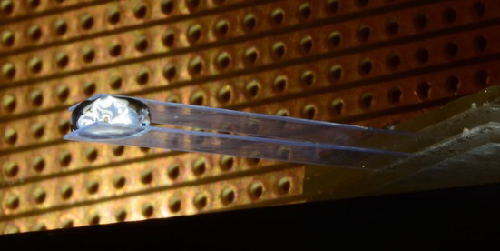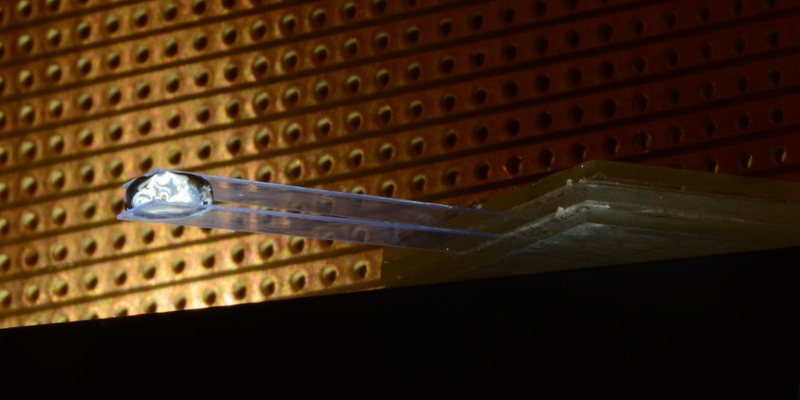Drop Motion Is All in the Bend
Turn on the tap and water gushes out, pushed through the faucet by pumps or gravity. These and other forces can also push liquids along much narrower pipes, like the micrometer-wide conduits used in lab-on-a-chip technologies to sequence DNA or synthesize chemicals. In all these cases, though, the liquid stops flowing if the driving force goes away. Now researchers have demonstrated a way that liquid drops will move along a slender channel under their own volition. The mechanism could find use in applications ranging from targeted drug delivery to self-clearing pipes.
To move fluids through the channels of a microfluidic device, scientists have used temperature gradients, electric fields, and chemical patterns. But the need for an external force in most such methods has led some researchers to search for alternative strategies in which liquids can propel themselves along a channel. Dominic Vella and colleagues at the University of Oxford, UK, have now found one such mechanism.
To create a narrow channel, the team coated a pair of thin, half-centimeter-wide glass coverslips with a material that repelled water but attracted oil. Then they clamped the coated coverslips at one end, holding them apart with a glass spacer a few hundred micrometers thick. The parallel coverslips were rigid enough to form a long channel but were also somewhat flexible.
The team deposited between 10 and 25 microliters of either oil or water into the closed end of the channel and observed the motion of the droplets. Regardless of the type of liquid, all of the droplets moved towards the channel’s open end, with the channel walls bending slightly inward or outward in the process. With oil, the interaction between the coating and liquid was attractive. The drop spread out, or “wetted,” the glass and pulled on the walls, drawing the free ends of the coverslips closer together, so that the channel tapered toward its open end. But with water, the coating and drop repelled each other—a “nonwetting” interaction—so the coverslips bent away from each other, making the open end wider.
The cause of the drop motion, the team deduced, is a variation in the pressure—a pressure gradient—along the length of the drop, and this gradient is induced by the liquid-channel interactions. The narrowing or widening of the channel by the drop distorts the drop’s shape, making it asymmetric from front to back. This shape change sets up a pressure gradient within the drop that leads to a variation in how strongly it pulls on the channel sides. For a wetting drop, the pulling force is stronger at the narrow end. As the drop tries to minimize its surface tension energy by changing its shape, it moves toward the channel’s open end. A nonwetting drop, by contrast, pushes the channel walls apart, and its internal pressure is lowest at the channel’s open end. The researchers found that this kind of drop also minimizes its energy by moving toward the open end of the channel. So once again, the drop breaks for freedom.
The researchers call this motion “bendotaxis” because “taxis” is a standard suffix for self-propulsion mechanisms of cells and organisms, and the motion here is induced by bending a material. “That both types of drop move in the same direction in bendotaxis is surprising,” Vella says. “In droplet physics we normally find that wetting and nonwetting drops behave differently.” This universal behavior could be useful for applications where the same pipe has to carry different liquids, for example.
Philippe Brunet, a physicist at Paris Diderot University who studies the behavior of drops, calls the results elegant and says that the mechanism constitutes a “practical way to move liquids within narrow channels.” He notes that the speed of motion demonstrated in the experiments is “rather slow”—the drops move at just a few hundred micrometers per second—but adds that this slowness could be an asset for drug delivery devices that would inject a liquid over a long period of time.
This research is published in Physical Review Letters.
–Katherine Wright
Katherine Wright is the Deputy Editor of Physics Magazine.





